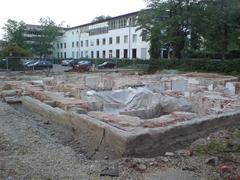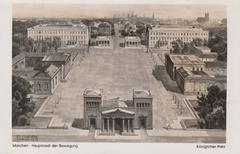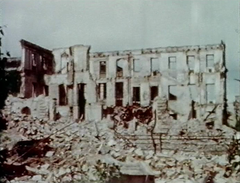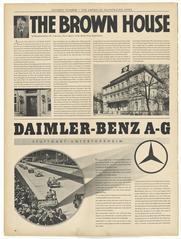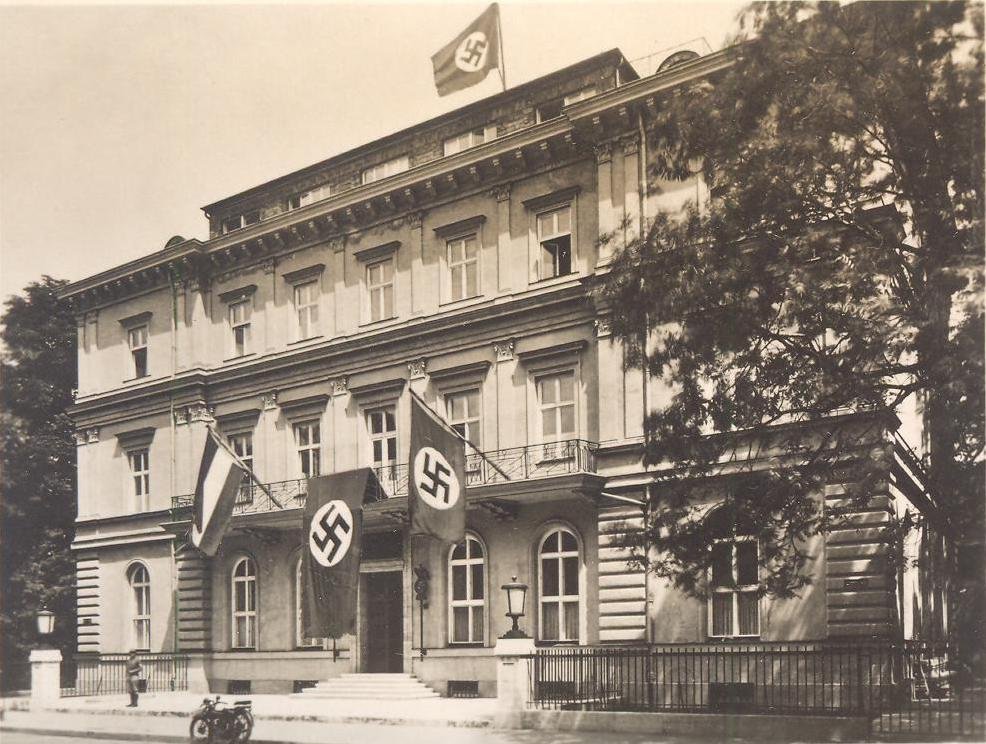
Braunes Haus Munich (NS-Dokumentationszentrum München): Comprehensive Visitor Guide for 2025
Date: 14/06/2025
Introduction
The site of the former Braunes Haus in Munich stands as a critical landmark in Germany’s history. Once the headquarters of the Nazi Party, it is now home to the NS-Dokumentationszentrum München, a museum and educational center devoted to the study and remembrance of National Socialism, its origins, consequences, and ongoing legacy. This detailed guide provides everything you need to know for a thoughtful and informed visit—including history, cultural significance, practical information, travel tips, nearby attractions, and accessibility. Whether you are a history enthusiast, student, or visitor seeking a meaningful experience, this resource will help you plan your visit to one of Munich’s most important historical sites.
Table of Contents
- Introduction
- Historical Overview & Architectural Transformation
- Visiting Hours, Admission, and Tickets
- Guided Tours, Educational Programs, and Special Events
- Accessibility & Facilities
- Travel Tips and Nearby Attractions
- Frequently Asked Questions (FAQ)
- Summary & Recommendations
- Sources and Further Reading
Historical Overview & Architectural Transformation
Early History and Original Construction
The building that became known as the Braunes Haus originated as a neoclassical city palace in 1828, designed by Jean Baptiste Métivier. Located on Brienner Straße, it was initially a symbol of Bavarian aristocracy, passing through several owners before being known as Palais Barlow. Its architecture featured symmetrical facades, grand columns, and dignified restraint, reflecting the era’s ideals of order and rationality.
Acquisition and Role as NSDAP Headquarters
In 1930, the National Socialist German Workers’ Party (NSDAP) purchased the palace, recognizing Munich’s importance as the so-called “capital of the movement.” Architect Paul Ludwig Troost oversaw its transformation into the party’s nerve center, while much of the neoclassical exterior remained. The interior was redesigned for administration, propaganda, and high-level meetings, with dark woods, austere décor, and prominent party insignia reflecting Nazi ideology. The building was renamed “Braunes Haus” after the brown uniforms of the Sturmabteilung (SA).
The site became synonymous with Nazi leadership, housing the offices of Adolf Hitler, Rudolf Hess, and Heinrich Himmler, and serving as the focal point for party strategy and operations (historicalsites.se).
Destruction, Postwar Memorialization, and the New Documentation Center
The Braunes Haus was badly damaged in Allied bombings in 1945 and its ruins were cleared in 1947. Unlike other Nazi-era buildings in Munich that were repurposed, this site remained empty—a symbol of the city’s reckoning with its past. In 2015, the NS-Dokumentationszentrum München was inaugurated on the site. Designed by architect Georg Scheel Wetzel, the modern white cubic building stands in stark contrast to its predecessor and embodies transparency, remembrance, and a commitment to democratic values. The Center offers permanent and rotating exhibitions, educational programs, and multimedia presentations to foster critical reflection on the mechanisms and consequences of National Socialism.
Visiting Hours, Admission, and Tickets
-
Opening Hours:
- Tuesday to Sunday: 10:00 AM – 7:00 PM
- Closed Mondays (except when a public holiday falls on Monday).
-
Admission:
- Free of charge for all visitors.
- Special exhibitions or guided tours may require advance booking.
-
Location:
- Max-Mannheimer-Platz 1, 80333 München (formerly Brienner Straße 45)
- Centrally located near Königsplatz, easily accessible by public transport.
For the latest details, consult the official NS-Dokumentationszentrum München website.
Guided Tours, Educational Programs, and Special Events
The Documentation Center offers a robust program of educational activities:
- Guided Tours: Available in German and English; bookable in advance for individuals, groups, and school classes.
- Audio Guides: Free, available in multiple languages.
- Workshops & Lectures: Regular events, including panel discussions and exhibition openings.
- Special Exhibitions: Thematic projects exploring various aspects of Nazi history and its relevance today.
For updated events and booking details, visit the official events page.
Accessibility & Facilities
The NS-Dokumentationszentrum München is fully accessible:
- Physical Accessibility: Barrier-free entrances, elevators to all floors, accessible restrooms, and low thresholds.
- Visitor Support: Staff available to assist; visitors with special needs are encouraged to contact the Center in advance.
- Facilities:
- Bookshop with German and English titles
- Café (added in 2025 after renovation)
- Free Wi-Fi
- Cloakroom and lockers (whichmuseum.com)
Travel Tips and Nearby Attractions
Getting There
-
Public Transport:
- U-Bahn: Königsplatz (U2), Stiglmaierplatz (U1)
- Tram: Lines 27, 28 (Karolinenplatz stop)
- Bus: Lines 100 (Museum line) and 150
- S-Bahn: Hauptbahnhof or Karlsplatz (Stachus), then a 10-minute walk (kunstareal.de)
-
No on-site parking: Use public transport or nearby paid parking.
Nearby Attractions
- Königsplatz: Historic square with classical architecture and museums.
- Karolinenplatz: Known for the Siegestor (Victory Gate).
- Munich Residenz: Royal palace of the Bavarian monarchs.
- Other Museums: Glyptothek, Lenbachhaus, Alte Pinakothek (all within Kunstareal district).
Visitor Tips
- Best times: Weekday mornings are least crowded.
- Recommended duration: 2–4 hours for a full visit.
- Photography: Allowed without flash or tripods, except where noted.
- Children: Content is serious; parental discretion advised.
- Plan ahead: Check for special exhibitions or events before your visit.
- Digital resources: Download the “Places to Remember” app for a self-guided tour of Munich’s Nazi history sites (muenchen.de).
Frequently Asked Questions (FAQ)
Q: What are the opening hours?
A: Tuesday to Sunday, 10:00 AM–7:00 PM. Closed Mondays except public holidays.
Q: Is admission free?
A: Yes, entry to the permanent exhibition is free. Some events or special exhibitions may require tickets.
Q: Are guided tours available?
A: Yes, in both German and English. Book online or at the museum.
Q: Is the Center accessible for visitors with disabilities?
A: Yes, with barrier-free access, elevators, and accessible restrooms.
Q: Can I take photos inside?
A: Personal photography is generally allowed, but not with flash or tripods.
Q: Is it suitable for children?
A: The subject matter is serious; use parental discretion for younger visitors.
Q: How do I get there by public transport?
A: U-Bahn to Königsplatz (U2) or Stiglmaierplatz (U1), plus tram and bus options.
Summary & Recommendations
Visiting the Braunes Haus site and the NS Documentation Center offers a profound and educational experience, providing crucial insights into Munich’s—and Germany’s—Nazi history. The transformation from the NSDAP’s headquarters into a center for democratic education and remembrance exemplifies Munich’s dedication to confronting its past responsibly. With free admission, accessible facilities, and a wealth of exhibitions and educational initiatives, the Center encourages visitors to reflect on the origins, mechanisms, and consequences of National Socialism.
The site’s central location makes it easy to combine with visits to other important Munich landmarks. Use digital tools like the Audiala app for self-guided tours, and stay updated via the Center’s official channels. For the most current visitor information, check the NS-Dokumentationszentrum München official site and the Munich tourism portal.
Sources and Further Reading
- Visiting the Braunes Haus and NS Documentation Center in Munich: History, Tickets, and Hours, 2025, (NS-Dokumentationszentrum München official site)
- Braunes Haus Munich: Visiting Hours, Tickets, and Historical Significance, 2025, (historicalsites.se)
- Munich Documentation Center for the History of National Socialism: Visiting Hours, Tickets, and Guide, 2025, (kunstareal.de)
- Practical Visitor Information and Cultural Considerations, 2025, (whichmuseum.com)
- Munich Tourist Information, 2025, (Munich Tourist Information)
- Lonely Planet Munich Travel Tips, 2025, (Lonely Planet Munich)
- Destination Munich: Munich Documentation Centre for the History of National Socialism, 2025, (destination-munich.com)

